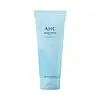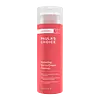What's inside
What's inside
 Key Ingredients
Key Ingredients

 Benefits
Benefits

 Concerns
Concerns

 Ingredients Side-by-side
Ingredients Side-by-side

Water
Skin ConditioningGlycerin
HumectantPalmitic Acid
EmollientStearic Acid
CleansingMyristic Acid
CleansingPotassium Hydroxide
BufferingLauric Acid
CleansingCocamidopropyl Betaine
CleansingEnteromorpha Compressa Extract
Skin ProtectingCodium Tomentosum Extract
Skin ProtectingSodium Chloride
MaskingUndaria Pinnatifida Extract
Skin ConditioningParfum
MaskingButylene Glycol
HumectantSodium Benzoate
MaskingPotassium Sorbate
PreservativeAcrylates/C10-30 Alkyl Acrylate Crosspolymer
Emulsion StabilisingPEG-14m
Emulsion StabilisingArachidic Acid
CleansingCellulose Gum
Emulsion Stabilising1,2-Hexanediol
Skin ConditioningDisodium EDTA
Silica
AbrasiveCitrus Paradisi Fruit Extract
Skin ConditioningSaponaria Officinalis Leaf/Root Extract
Skin ConditioningMaris Aqua
HumectantCaprylic/Capric Triglyceride
MaskingHydrogenated Lecithin
EmulsifyingButyrospermum Parkii Butter
Skin ConditioningSodium Hyaluronate
HumectantCeramide NP
Skin ConditioningCeramide AP
Skin ConditioningCeramide Ns
Skin ConditioningCholesterol
EmollientCeramide As
Skin ConditioningEucalyptus Globulus Leaf Extract
PerfumingMadecassic Acid
Skin ConditioningPhytosphingosine
Skin ConditioningAsiatic Acid
Skin ConditioningAsiaticoside
AntioxidantCeramide EOP
Skin ConditioningWater, Glycerin, Palmitic Acid, Stearic Acid, Myristic Acid, Potassium Hydroxide, Lauric Acid, Cocamidopropyl Betaine, Enteromorpha Compressa Extract, Codium Tomentosum Extract, Sodium Chloride, Undaria Pinnatifida Extract, Parfum, Butylene Glycol, Sodium Benzoate, Potassium Sorbate, Acrylates/C10-30 Alkyl Acrylate Crosspolymer, PEG-14m, Arachidic Acid, Cellulose Gum, 1,2-Hexanediol, Disodium EDTA, Silica, Citrus Paradisi Fruit Extract, Saponaria Officinalis Leaf/Root Extract, Maris Aqua, Caprylic/Capric Triglyceride, Hydrogenated Lecithin, Butyrospermum Parkii Butter, Sodium Hyaluronate, Ceramide NP, Ceramide AP, Ceramide Ns, Cholesterol, Ceramide As, Eucalyptus Globulus Leaf Extract, Madecassic Acid, Phytosphingosine, Asiatic Acid, Asiaticoside, Ceramide EOP
Water
Skin ConditioningSodium Cocoyl Glycinate
CleansingCocamidopropyl Hydroxysultaine
CleansingSodium Lauroamphoacetate
CleansingCocamidopropyl Betaine
CleansingGlycerin
HumectantSorbeth-230 Tetraoleate
EmulsifyingDecyl Glucoside
CleansingPentylene Glycol
Skin ConditioningSodium Chloride
MaskingDisodium Cocoyl Glutamate
CleansingLauric Acid
CleansingLactic Acid
BufferingSodium Lauroyl Oat Amino Acids
CleansingSorbitan Laurate
EmulsifyingSodium Cocoyl Glutamate
CleansingDisodium EDTA
Aloe Barbadensis Leaf Juice Powder
Skin ConditioningCaprylic/Capric Triglyceride
MaskingCocoyl Proline
Skin ConditioningSodium Citrate
BufferingCamellia Sinensis Leaf Extract
AntimicrobialGlycyrrhiza Glabra Root
Skin ConditioningSodium PCA
HumectantSodium Lactate
BufferingArginine
MaskingGlycine Soja Sterols
EmollientLinoleic Acid
CleansingPhospholipids
Skin ConditioningAspartic Acid
MaskingPCA
HumectantGlycine
BufferingAlanine
MaskingSerine
MaskingValine
MaskingIsoleucine
Skin ConditioningProline
Skin ConditioningThreonine
Potassium Citrate
BufferingLactoperoxidase
StabilisingHistidine
HumectantPhenylalanine
MaskingGlucose Oxidase
StabilisingCitric Acid
BufferingPhenoxyethanol
PreservativeEthylhexylglycerin
Skin ConditioningPotassium Sorbate
PreservativeSodium Benzoate
MaskingWater, Sodium Cocoyl Glycinate, Cocamidopropyl Hydroxysultaine, Sodium Lauroamphoacetate, Cocamidopropyl Betaine, Glycerin, Sorbeth-230 Tetraoleate, Decyl Glucoside, Pentylene Glycol, Sodium Chloride, Disodium Cocoyl Glutamate, Lauric Acid, Lactic Acid, Sodium Lauroyl Oat Amino Acids, Sorbitan Laurate, Sodium Cocoyl Glutamate, Disodium EDTA, Aloe Barbadensis Leaf Juice Powder, Caprylic/Capric Triglyceride, Cocoyl Proline, Sodium Citrate, Camellia Sinensis Leaf Extract, Glycyrrhiza Glabra Root, Sodium PCA, Sodium Lactate, Arginine, Glycine Soja Sterols, Linoleic Acid, Phospholipids, Aspartic Acid, PCA, Glycine, Alanine, Serine, Valine, Isoleucine, Proline, Threonine, Potassium Citrate, Lactoperoxidase, Histidine, Phenylalanine, Glucose Oxidase, Citric Acid, Phenoxyethanol, Ethylhexylglycerin, Potassium Sorbate, Sodium Benzoate
 Reviews
Reviews

Ingredients Explained
These ingredients are found in both products.
Ingredients higher up in an ingredient list are typically present in a larger amount.
This ingredient is an emollient, solvent, and texture enhancer. It is considered a skin-softener by helping the skin prevent moisture loss.
It helps thicken a product's formula and makes it easier to spread by dissolving clumping compounds.
Caprylic Triglyceride is made by combining glycerin with coconut oil, forming a clear liquid.
While there is an assumption Caprylic Triglyceride can clog pores due to it being derived from coconut oil, there is no research supporting this.
Learn more about Caprylic/Capric TriglycerideCocamidopropyl Betaine is a fatty acid created by mixing similar compounds in coconut oil and dimethylaminopropylamine, a compound with two amino groups.
This ingredient is a surfactant and cleanser. It helps gather the dirt, pollutants, and other impurities in your skin to be washed away. It also helps thicken a product and make the texture more creamy.
Being created from coconut oil means Cocamidopropyl Betaine is hydrating for the skin.
While Cocamidopropyl Betaine was believed to be an allergen, a study from 2012 disproved this. It found two compounds in unpure Cocamidopropyl Betaine to be the irritants: aminoamide and 3-dimethylaminopropylamine. High-grade and pure Cocamidopropyl Betaine did not induce allergic reactions during this study.
Learn more about Cocamidopropyl BetaineDisodium EDTA plays a role in making products more stable by aiding other preservatives.
It is a chelating agent, meaning it neutralizes metal ions that may be found in a product.
Disodium EDTA is a salt of edetic acid and is found to be safe in cosmetic ingredients.
Learn more about Disodium EDTAGlycerin is already naturally found in your skin. It helps moisturize and protect your skin.
A study from 2016 found glycerin to be more effective as a humectant than AHAs and hyaluronic acid.
As a humectant, it helps the skin stay hydrated by pulling moisture to your skin. The low molecular weight of glycerin allows it to pull moisture into the deeper layers of your skin.
Hydrated skin improves your skin barrier; Your skin barrier helps protect against irritants and bacteria.
Glycerin has also been found to have antimicrobial and antiviral properties. Due to these properties, glycerin is often used in wound and burn treatments.
In cosmetics, glycerin is usually derived from plants such as soybean or palm. However, it can also be sourced from animals, such as tallow or animal fat.
This ingredient is organic, colorless, odorless, and non-toxic.
Glycerin is the name for this ingredient in American English. British English uses Glycerol/Glycerine.
Learn more about GlycerinLauric Acid is a fatty acid or lipid. About half of fatty acids in coconut oil is lauric acid.
This ingredient helps hydrate and sooth skin. As a humectant, it helps trap moisture. It also aids in cleaning and enhancing the texture of products.
Lauric acid may not be Malassezia folliculitis, or fungal acne, safe.
Learn more about Lauric AcidPotassium Sorbate is a preservative used to prevent yeast and mold in products. It is commonly found in both cosmetic and food products.
This ingredient comes from potassium salt derived from sorbic acid. Sorbic acid is a natural antibiotic and effective against fungus.
Both potassium sorbate and sorbic acid can be found in baked goods, cheeses, dried meats, dried fruit, ice cream, pickles, wine, yogurt, and more.
You'll often find this ingredient used with other preservatives.
Learn more about Potassium SorbateSodium Benzoate is a preservative. It's used in both cosmetic and food products to inhibit the growth of mold and bacteria. It is typically produced synthetically.
Both the US FDA and EU Health Committee have approved the use of sodium benzoate. In the US, levels of 0.1% (of the total product) are allowed.
Sodium benzoate works as a preservative by inhibiting the growth of bacteria inside of cells. It prevents the cell from fermenting a type of sugar using an enzyme called phosphofructokinase.
It is the salt of benzoic acid. Foods containing sodium benzoate include soda, salad dressings, condiments, fruit juices, wines, and snack foods.
Studies for using ascorbic acid and sodium benzoate in cosmetics are lacking, especially in skincare routines with multiple steps.
We always recommend speaking with a professional, such as a dermatologist, if you have any concerns.
Learn more about Sodium BenzoateChances are, you eat sodium chloride every day. Sodium Chloride is also known as table salt.
This ingredient has many purposes in skincare: thickener, emulsifier, and exfoliator.
You'll most likely find this ingredient in cleansers where it is used to create a gel-like texture. As an emulsifier, it also prevents ingredients from separating.
There is much debate on whether this ingredient is comedogenic. The short answer - comedogenic ratings don't tell the whole story. Learn more about comegodenic ratings here.
The concensus about this ingredient causing acne seems to be divided. Research is needed to understand if this ingredient does cause acne.
Scrubs may use salt as the primary exfoliating ingredient.
Learn more about Sodium ChlorideWater. It's the most common cosmetic ingredient of all. You'll usually see it at the top of ingredient lists, meaning that it makes up the largest part of the product.
So why is it so popular? Water most often acts as a solvent - this means that it helps dissolve other ingredients into the formulation.
You'll also recognize water as that liquid we all need to stay alive. If you see this, drink a glass of water. Stay hydrated!
Learn more about Water